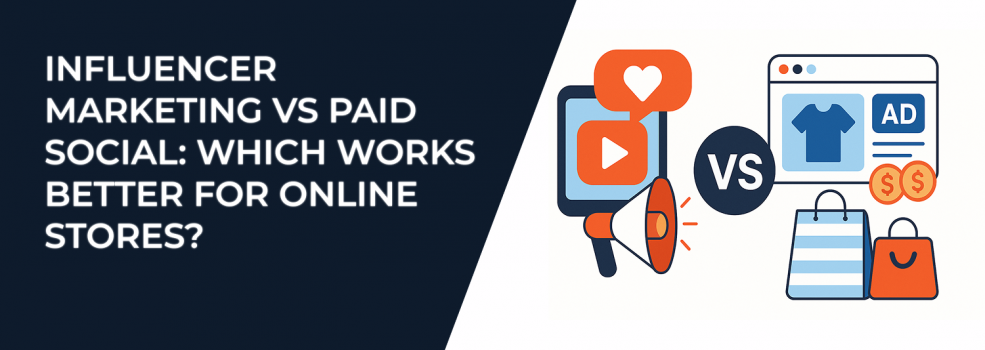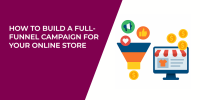If you run an online store, you’ve likely asked this question: Should I invest in influencer marketing or paid social ads?
It’s a fair question — and not always an easy one to answer.
Both influencer marketing and paid social campaigns can drive traffic, boost sales, and increase brand awareness. But they do it in different ways, with different risks and rewards. The trick is figuring out which approach fits your brand, your goals, and your budget.
Let’s break it down.
What Is Influencer Marketing?
Influencer marketing is about partnering with individuals who have built trust with a specific audience — whether that’s on Instagram, TikTok, YouTube, or even LinkedIn. They promote your product or service in their own voice, through stories, reels, posts, or videos.
Sounds simple enough, right?
But don’t confuse simplicity with ease. Getting real results from influencer collaborations takes strategy, research, and often... patience.
Pros of Influencer Marketing:
-
Authenticity drives conversions. People trust people. A recommendation from someone they follow daily carries weight — far more than a banner ad ever could.
-
Niche targeting made easy. Influencers usually speak to tight-knit communities. If you sell hiking gear, a micro-influencer who climbs every weekend might be a better bet than a broad ad campaign.
-
Content you can reuse. Many influencers are skilled content creators. The images, videos, and stories they produce can be repurposed across your own social and paid channels.
These benefits make influencer marketing a great fit for brands looking to build long-term relationships with their audience. It’s less about instant sales, more about trust and storytelling — which can pay off big in the long run.
If you're planning to reuse influencer content in your ads, check out this guide on how to boost your Facebook and Instagram ads with influencer partnerships — it’s a tactic many top-performing e-commerce stores are using to double down on performance.
Cons to Keep in Mind:
-
Harder to measure ROI. Unless you’re working with affiliate links, tracking exact conversions from influencer posts can be murky.
-
Time-consuming. Vetting influencers, negotiating rates, and coordinating content takes time — and it doesn’t always scale quickly.
-
Risk of misalignment. If the influencer doesn’t genuinely like or understand your product, the promotion can fall flat — or worse, hurt your brand.
These drawbacks don’t mean influencer marketing should be avoided — they just highlight the need for a solid vetting and tracking process. Choose partners carefully and always define expectations clearly.
What Is Paid Social Advertising?
Paid social refers to the sponsored ads you run on platforms like Facebook, Instagram, TikTok, or Pinterest. You control the copy, the creative, the audience, the timing — everything.
It’s like running your own digital billboard, except smarter.
Pros of Paid Social:
-
Precise targeting. Want to show your ad to women aged 25–34 who recently visited your website and live in urban areas? Done.
-
Fast results. Need to boost traffic for a product launch tomorrow? Paid social gets eyes on your offer, fast.
-
A/B testing and scaling. With the right tools, you can test ad variations, monitor performance in real-time, and scale what works — all without relying on third parties.
These benefits make paid social a strong contender for online stores focused on short-term growth, performance, and agility. When speed and scale matter, this is often the way to go.
You’ll want to pay close attention to emotional hooks and messaging if you go this route. The psychology of Facebook ads is a powerful lever — especially when you're working with cold audiences that don’t yet know or trust your brand.
What to Watch Out For:
-
Ad fatigue is real. People scroll quickly. If your creative doesn’t pop or your frequency gets too high, you’re wasting money.
-
Costs can climb fast. Especially in competitive markets. You need to manage budgets and bids carefully.
-
Algorithm dependency. If your targeting is off — or the platform changes — your results can vanish overnight.
If your paid campaigns are live but not delivering, here’s what to do next: read Facebook Ads Not Converting: How To Fix It for practical tips on diagnosing targeting, creative, and offer issues.
So, Which One Works Better?
Let’s get honest: there’s no single winner here.
Influencer marketing might work wonders for a small lifestyle brand trying to build a community. Meanwhile, a data-driven online store launching a flash sale might find paid social more predictable and easier to scale.
But ask yourself:
-
Are you looking for long-term brand equity or short-term sales?
-
Do you have time to build partnerships — or do you need results this week?
-
Can you create compelling ad content in-house — or would you benefit from influencer-created visuals?
Answering these questions will steer you toward the right approach — or a hybrid of the two. The more clearly you understand your goals, the easier it becomes to choose a strategy that supports them.
Need help defining your audience? Start with this step-by-step guide on how to define a target audience for marketing. Whether you're targeting through influencers or ads, it all starts there.
The Smartest Online Stores Use Both
Here’s where things get interesting: the most effective marketers often don’t choose. They combine both strategies — letting each one do what it does best.
Here’s how that can look:
-
Influencer collaborations drive discovery and create fresh, trust-based content.
-
Paid social ads then amplify the best-performing content to a broader, targeted audience.
This blend offers the best of both worlds. You get the authenticity of influencers plus the precision and scale of paid campaigns. It’s a strategy that’s flexible, future-proof, and proven to work when executed thoughtfully.
If you're comparing Facebook vs Instagram performance within paid social, here's a helpful breakdown: Facebook Ads vs Instagram Ads: Which Is Better for Your Business?
Practical Tips for E-Commerce Marketers
If you’re trying to decide how to allocate budget, consider these tips:
-
Start with your customer. Where do they hang out? What voices do they trust? What kind of content do they engage with?
-
Pilot before you scale. Test one influencer campaign or one ad set at a time. Track your numbers. Learn what works.
-
Use influencer content in paid ads. It’s called whitelisting — and it can give your ads a human voice that boosts CTR and lowers CPM.
-
Measure everything. Use UTMs, pixel tracking, and platform analytics to compare results honestly.
-
Don’t get emotional. If something isn’t converting, pause it. Look at the data. Iterate.
Apply these tips to build a strategy that actually supports your bottom line. Whether you're bootstrapping or scaling fast, making informed decisions is what separates growth from guesswork.
Final Thoughts
Influencer marketing and paid social each offer unique advantages. They aren’t interchangeable — they’re complementary. When you understand the strengths and weaknesses of both, you’re no longer guessing.
You're building a strategy. And strategies win.

